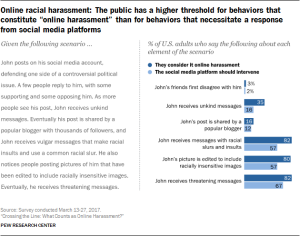
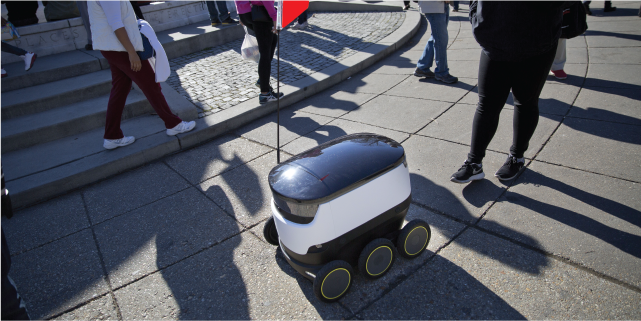
How realistic are the scenarios presented in the survey?
Some of the scenarios presented in the survey are more futuristic than others:
Today companies can utilize computer algorithms in various aspects of the hiring process – from identifying candidates who might be overlooked in traditional face-to-face recruiting, to automatically eliminating applicants who lack certain characteristics.
Americans today cannot purchase a fully autonomous vehicle. But a number of companies are developing and testing these vehicles, and many modern cars offer semi-autonomous features such as adaptive cruise control or lane-assist technology.
A wide range of robotic devices are being developed to help meet the demands of an aging population. But it will likely be many years before fully autonomous robot caregivers as described in this survey are available for use.
More broadly, these developments speak to the possibility of a world in which robots and computer applications are capable of performing many of the tasks currently done by humans – with potentially profound implications for society as a whole.
Advances in robotics and artificial intelligence have the potential to automate a wide range of human activities and to dramatically reshape the way that Americans live and work in the coming decades. A Pew Research Center survey of 4,135 U.S. adults conducted May 1-15, 2017, finds that many Americans anticipate significant impacts from various automation technologies in the course of their lifetimes – from the widespread adoption of autonomous vehicles to the replacement of entire job categories with robot workers. Although they expect certain positive outcomes from these developments, their attitudes more frequently reflect worry and concern over the implications of these technologies for society as a whole.
To gauge the opinions of everyday Americans on this complex and far-reaching topic, the survey presented respondents with four different scenarios relating to automation technologies. Collectively, these scenarios speak to many of the hopes and concerns embedded in the broader debate over automation and its impact on society. The scenarios included: the development of autonomous vehicles that can operate without the aid of a human driver; a future in which robots and computers can perform many of the jobs currently done by human workers; the possibility of fully autonomous robot caregivers for older adults; and the possibility that a computer program could evaluate and select job candidates with no human involvement. The following are among the major findings.
Americans express widespread concern – but also tempered optimism – about the impact of emerging automation technologies
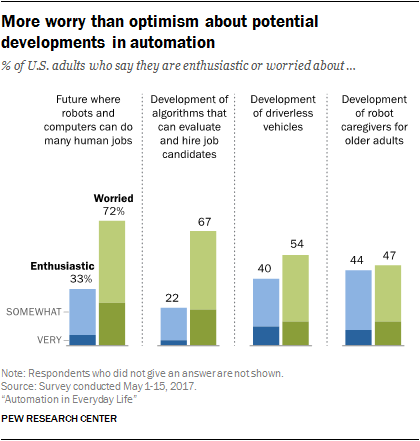
Americans generally express more worry than enthusiasm when asked about these automation technologies. Most prominently, Americans are roughly twice as likely to express worry (72%) than enthusiasm (33%) about a future in which robots and computers are capable of doing many jobs that are currently done by humans. They are also around three times as likely to express worry (67%) than enthusiasm (22%) about algorithms that can make hiring decisions without any human involvement. By comparison, public views towards driverless vehicles and robot caregivers exhibit more balance between worry and enthusiasm.
The public also expresses a number of concerns when asked about the likely outcomes they anticipate from these technological developments. For instance, 76% of Americans expect that economic inequality will become much worse if robots and computers are able to perform many of the jobs that are currently done by humans. A similar share (75%) anticipates that the economy will not create many new, better-paying jobs for humans if this scenario becomes a reality. And 64% expect that people will have a hard time finding things to do with their lives if forced to compete with advanced robots and computers for jobs.
In the case of driverless vehicles, 75% of the public anticipates that this development will help the elderly and disabled live more independent lives. But a slightly larger share (81%) expects that many people who drive for a living will suffer job losses as a result. And although a plurality (39%) expects that the number of people killed or injured in traffic accidents will decrease if driverless vehicles become widespread, another 30% thinks that autonomous vehicles will make the roads less safe for humans. Similarly, seven-in-ten Americans (70%) anticipate that robot caregivers would help alleviate the burden of caring for aging relatives – but nearly two-thirds (64%) expect that these technologies would increase feelings of isolation for the older adults in their care.
Majorities of Americans are reluctant to use emerging automation technologies themselves and express concerns about removing the human element from important decisions
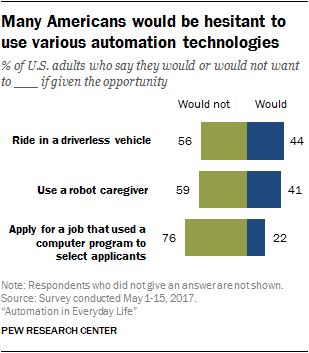
A sizable share of the public expresses reservations about personally using each of the technological concepts examined in the survey. Nearly six-in-ten Americans say they would not want to ride in a driverless vehicle or use a robot caregiver for themselves or a family member, while roughly three-quarters would not want to apply for a job that used a computer program to evaluate and select applicants.
Those who are hesitant to use these technologies frequently describe their concerns as stemming from a lack of trust in technological decision-making and an appreciation for the unique capabilities and expertise of humans. For instance, roughly seven-in-ten Americans who would not want to ride in a driverless vehicle mention a lack of trust, a fear of losing control and/or general safety concerns when asked why they would not want to use this technology.
Survey respondents’ comments about robot caregivers and hiring algorithms also frequently point to the importance of human contact and decision-making and their worries that even the most advanced machines could never replicate these attributes.
Broad public support for policies that limit the use of automation technologies or bring humans more fully into the process
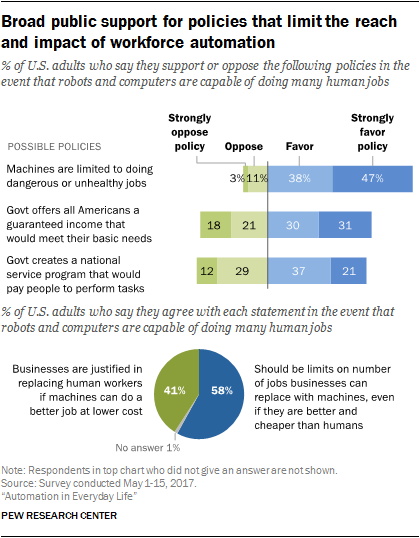
Along with these concerns, the public generally responds favorably to policies that would limit the use of these technologies to specific situations or that would bring human beings more fully into their operations. In the event that robots and computers become capable of doing many human jobs, for example, 85% of Americans are in favor of limiting machines to performing primarily those jobs that are dangerous or unhealthy for humans. Were robots and computers to become widely competitive with human workers, majorities would also support providing all Americans with a guaranteed income that would allow people to meet their basic needs (60% in favor), as well as a national service program that would pay humans to perform jobs even if machines could do them faster or cheaper (58% in favor). In addition, a notably larger share of the public sides with the notion that there should be limits on the number of jobs businesses can replace with machines, as opposed to the idea that businesses are justified in automating human jobs if they can receive better work at lower cost (by a 58% to 41% margin).
Democrats and Democratic-leaning independents are substantially more likely than Republicans and Republican-leaning independents to favor both a universal income (by a 77% to 38% margin) and a national service program (by a 66% to 46% margin) in the event that machines threaten to displace substantial numbers of human workers. But the vast majority of Americans – regardless of party affiliation – support limiting machines to performing dangerous and dirty jobs. And roughly comparable shares of Democrats (60%) and Republicans (54%) feel that there should generally be limits on the number of jobs businesses can replace with robots or computers.
The desire for increased human control of these technologies is present in Americans’ attitudes toward other concepts in this survey as well. The vast majority of Americans (87%) would favor a requirement that all driverless vehicles have a human in the driver’s seat who can take control of the vehicle in the event of an emergency, with 53% favoring this policy strongly. Meanwhile, roughly half (48%) of Americans would feel better about the concept of a robot caregiver if there was a human operator who could remotely monitor its actions at all times. And 57% would feel better about the concept of a hiring algorithm if it was only used for the initial screening of job candidates prior to a traditional in-person interview.
A key attitudinal divide around emerging automation technologies: Those who are excited to try these technologies themselves versus those who are more hesitant
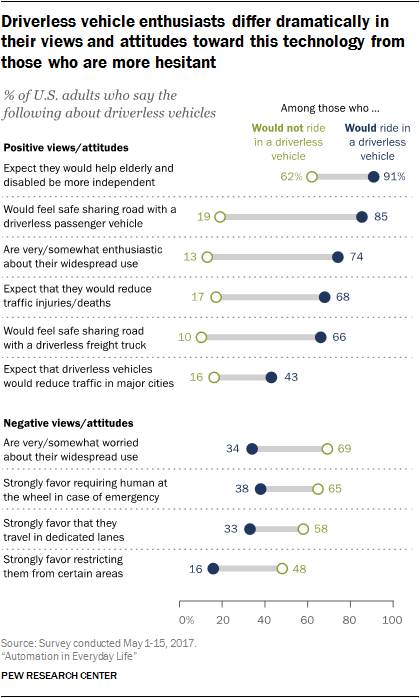
For each of the concepts examined in the survey, Americans who themselves would be interested in using these technologies express substantially more positive attitudes towards them than those who would not. These enthusiasts also anticipate a wider range of positive societal impacts if these technologies become widespread.
Driverless vehicles represent an especially vivid example of this trend. Americans who themselves would ride in a driverless vehicle express greater levels of enthusiasm and lower levels of worry about the ultimate impact of this technology compared with those who are more reticent, and they are more likely to say they would feel safe sharing the road with both autonomous cars and freight vehicles. This group is also more likely to think that autonomous vehicles will reduce traffic fatalities and help the elderly and disabled live more independent lives, and they are much less supportive of various rules or policies restricting their use.
Many Americans expect a number of professions to be dominated by machines within their lifetimes – but relatively few expect their own jobs or professions to be impacted
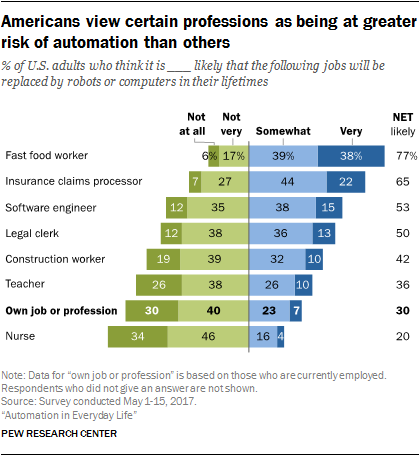
Beyond the examples noted above, Americans anticipate significant changes to the nature of jobs and work in the coming decades as a result of automation. Overall, roughly three-quarters of Americans (77%) think it’s realistic that robots and computers might one day be able to do many of the jobs currently done by humans, with 20% describing this prospect as extremely realistic. And substantial shares of Americans anticipate that automation will impact a number of specific career fields over the course of their lifetimes. Sizable majorities expect that jobs such as fast food workers and insurance claims processors will be mostly performed by machines during that timeframe, while around half expect that the same will be true of jobs such as software engineers and legal clerks.
At the same time, few of today’s workers expect that their own jobs or professions are at risk of being automated. In total, just 30% of workers think it’s at least somewhat likely that their jobs will be mostly done by robots or computers during their lifetimes. Indeed, roughly four times as many workers describe this outcome as “not at all likely” (30%) as describe it as “very likely” (7%). Workers in certain industries (such as hospitality and service, or retail) are more likely to view their jobs as being at risk compared with those in others (such as education). But across a range of occupations, majorities of workers anticipate that their jobs or professions will not be impacted by automation to a significant degree.
6% of Americans report that they have already been impacted by automation in the form of lost jobs and/or wages
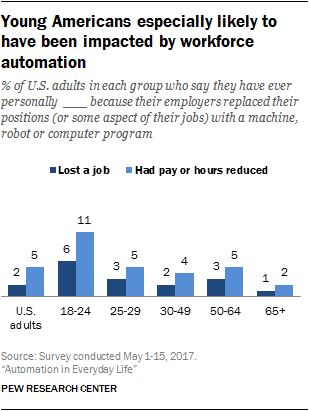
Much of this survey focuses on possible future impacts of automation, but a minority of Americans are already being impacted by these technologies in their own jobs and careers. Specifically, 2% of Americans report that they have ever personally lost a job because their employers replaced their positions with a machine or computer program. Another 5% report that they have ever had their pay or hours reduced for the same reason. Taken together, that works out to 6% of U.S. adults who report having been impacted by workforce automation in one (or both) of these ways. The youngest adults – those ages 18 to 24 – are among the groups most likely to have been personally impacted by workforce automation. This experience is also more common than average among Latinos, part-time workers and those with relatively low household incomes.
Although they comprise a relatively small share of the population, these workers who have been impacted by automation express strongly negative views about the current – and future – impact of technology on their own careers. Fully 46% of these workers feel that technology has decreased their own opportunities for career advancement, while 34% feel that technology has generally made their work less interesting (each of these views is shared by just 11% of other workers). And nearly six-in-ten (57%) anticipate that their own jobs or professions will be mostly done by machines within their lifetimes – roughly twice the share among workers who have not been impacted by automation in this way (28%).
Workers lacking a college education are much less likely to express positive attitudes towards the current generation of workforce technologies
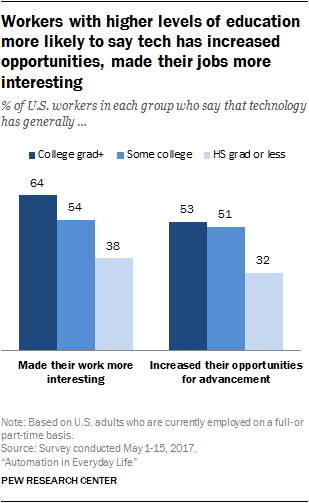
More broadly, the survey also finds that the current generation of workforce technologies has had widely disparate impacts on today’s workers. For some – especially those with high levels of educational attainment – technology represents a largely positive force that makes their work more interesting and provides opportunities for career advancement. But those who have not attended college are much less likely to view today’s workforce technologies in such a positive light.
The survey asked about the impact that six common workforce technologies have had on today’s workers. These include word processing and spreadsheet software; smartphones; email and social media; software that manages people’s daily schedules; technologies that help customers serve themselves without the assistance of a human worker; and industrial robots. It finds that workers with college degrees are substantially more likely than those who have not attended college to say that each of these individual technologies has had a positive impact on their jobs or careers. Indeed, roughly one-quarter (24%) of workers with high school diplomas or less say that not a single one of these six technologies has had a positive impact on their jobs or careers; for college graduates that share is just 2%.
When it comes to the overall impact of technology on them in a professional context, just 38% of workers with high school diplomas or less indicate that technology in general has made their jobs more interesting. And a similarly modest share (32%) feels that technology has increased their opportunities for career advancement. In each instance, these figures are substantially lower than those reported by workers who have continued their formal education beyond high school.
The public anticipates widespread advances in the development and adoption of automation technologies over the coming decades
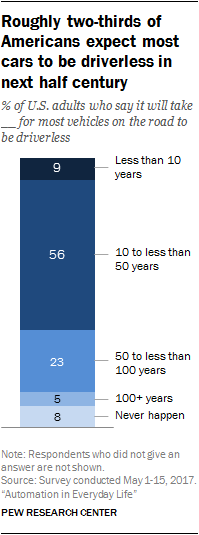
Many Americans anticipate that various automation technologies will make significant inroads in terms of their development and adoption in the coming decades. Driverless vehicles are perhaps the most prominent example of this trend. Fully 94% of Americans have some awareness of the effort to develop driverless vehicles, and roughly two-thirds of the public anticipates that most vehicles on the road will be driverless within the next half-century – with 9% predicting that this will occur in the next 10 years.
Additionally, substantial shares of Americans think it’s likely that within 20 years doctors will rely on computer programs to diagnose and treat most diseases (79% think this will definitely or probably happen); that most retail interactions will be fully automated and involve little or no human interaction between customers and employees (65%); and that most deliveries in cities will be made by robots or drones instead of humans (65%).




